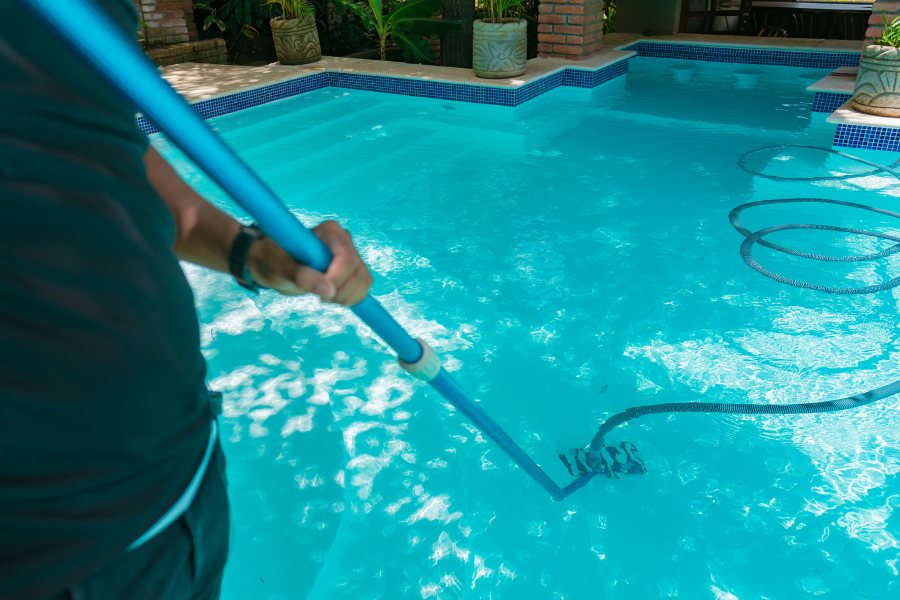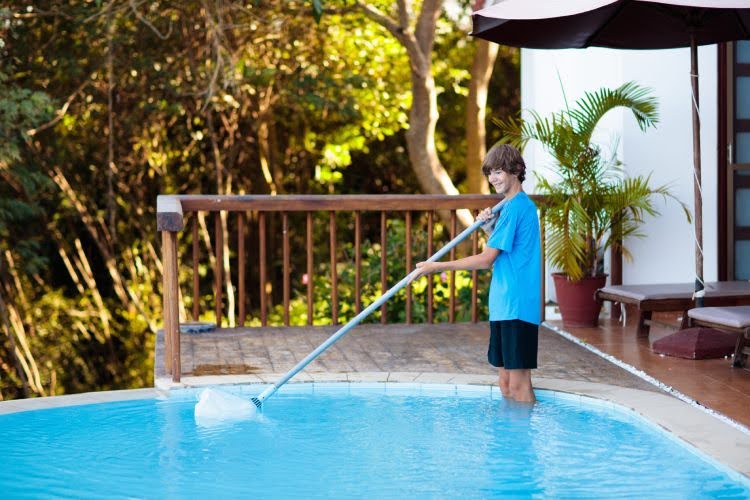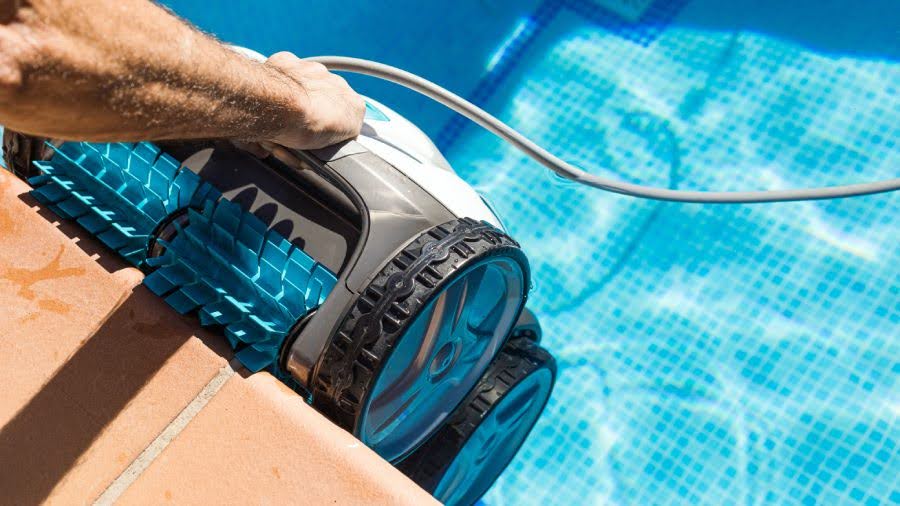How to Clean a Pool

Maintaining a pristine pool is essential for both the health of swimmers and the longevity of the pool itself. As the centerpiece of backyard relaxation and entertainment, a clean pool invites refreshing dips and creates a visually appealing oasis.
However, the task of pool maintenance can seem daunting to many homeowners, especially those new to pool ownership. From balancing chemicals to skimming debris, the process involves various steps that require attention to detail and consistency.
In this guide, we explore the proper techniques for how to clean a pool. The right method can make the difference between a sparkling aquatic retreat and a murky, uninviting mess.
The following tips and tricks will help you keep your pool in top condition throughout the swimming season and beyond. Whether you’re a seasoned pool owner or a novice, mastering the art of pool cleaning will ensure countless hours of aquatic enjoyment for years to come.

How to Clean a Pool
Maintaining a pristine pool involves more than just skimming the surface. Effective pool cleaning is a multi-faceted process that ensures your aquatic retreat remains inviting and hygienic. Let’s dive into the essential techniques that will keep your pool sparkling clean and ready for enjoyment.
- Skimming and removing debris
Maintaining a clean pool starts with regular skimming. Use a long-handled net skimmer to remove leaves, insects, and other floating debris from the water surface daily. Pay special attention to corners and areas where debris tends to accumulate.
Don’t forget to empty and clean the skimmer baskets, which trap larger particles before they enter the filtration system. For sunken debris, use a leaf rake or deep net to clean the pool bottom. This prevents staining and keeps your pool looking pristine.
- Brushing pool walls and floor
Weekly brushing is crucial for preventing algae growth and removing dirt buildup. Use the appropriate brush for your pool surface – stainless steel for concrete pools, and nylon for vinyl or fiberglass.
Start at the shallow end and work your way to the deep end, using firm, overlapping strokes. Pay extra attention to corners, steps, and areas with poor circulation. Brushing not only keeps your pool clean but also improves the efficiency of your chemical treatments by dislodging contaminants.
- Vacuuming the pool
Vacuuming removes debris that brushing has loosened. For manual vacuuming, attach the vacuum head to your telescopic pole and connect the hose to the skimmer inlet. Move slowly across the pool floor, overlapping your strokes for thorough cleaning.
Alternatively, automatic pool cleaners like robotic, suction-side, or pressure-side models can make this task easier. Whichever method you choose, regular vacuuming is essential for maintaining a clean, inviting pool.
- Cleaning the pool filter
Your pool’s filter system is crucial for keeping the water clean, so proper maintenance is essential. Speaking of filters, the sand filters backwash when the pressure gauge rises 8-10 PSI above normal. Cartridge filters need to be removed and hosed down regularly, with a deep clean using filter cleaner at least twice a season.
DE filters require backwashing similar to sand filters, but you’ll need to add fresh DE powder afterwards. Regardless of the type, clean filters regularly and replace them when they no longer function effectively.
- Testing and balancing pool water chemistry
Proper chemical balance is critical for safe, clean pool water. Test your pool water weekly for pH, chlorine, alkalinity, and cyanuric acid levels using test strips or a liquid test kit. Maintain pH between 7.2 and 7.6, free chlorine between 1 and 3 ppm, and total alkalinity between 80 and 120 ppm.
Adjust levels as needed using appropriate chemicals, allowing time for circulation before retesting. Balanced water not only ensures swimmer comfort and safety but also prevents equipment corrosion and makes your sanitizer more effective.
Tips on How to Clean Above Ground Pool
Above ground pools require specific care due to their unique structure. Here are the most crucial aspects of keeping your pool clean:
Gentle liner maintenance
The vinyl liner in above-ground pools is susceptible to damage. To clean it, use a soft-bristled brush or a pool sock attached to your telescopic pole. Avoid abrasive cleaners, which wear down the liner over time, opting instead for pool-safe, non-abrasive solutions.
Water level management
Maintain the water level at the midpoint of the skimmer opening for optimal functionality. When adding water, use a hose filter to remove impurities. Be cautious not to overfill, as excessive water can stress the pool walls and potentially lead to structural issues.
Skimmer and return jet care
Regular maintenance of the skimmer and return jet is crucial for effective water circulation and filtration. Clean the skimmer basket frequently and ensure the return jet is positioned correctly. Consider adding a skimmer sock for extra filtration.
Addressing metal stains
For pools with metal walls, promptly address any rust stains using a pumice stone or a commercial metal stain remover designed for pools. Apply a protective sealant to prevent future staining and extend the life of your pool structure.
Optimizing filtration
Establish an effective filtration schedule, typically running your pump and filter for 8-12 hours daily during peak season. Use a timer to automate this process and adjust filtration time based on pool usage and weather conditions.
By focusing on these essential aspects, you’ll maintain a clean and safe above ground pool while prolonging its lifespan.

How Long Does It Take to Clean a Pool
Cleaning a pool typically takes varying amounts of time depending on the task and pool size. Daily maintenance like skimming and checking chemical levels can be done in about 20-30 minutes. Weekly tasks such as brushing walls and vacuuming might take 1-2 hours.
Filter maintenance, including backwashing or cleaning cartridges, usually requires 30 minutes to two hours, depending on the filter type. Deep cleaning sessions, which include draining, acid washing, and refilling, can take 1-2 days. Seasonal opening and closing procedures often require 1-2 days as well.
Factors like pool type, size, and surrounding environment can significantly impact cleaning time. Using automatic cleaners and preventative measures like pool covers can help reduce the time needed for routine maintenance. Overall, regular upkeep is key to minimizing the time spent on major cleaning sessions.
Conclusion
We hope this article has helped you understand better the importance of regular maintenance and the steps involved in keeping your pool pristine. Learning how to clean a pool effectively is an essential skill for any pool owner.
By following the guidelines covered here, you’ll be well-equipped to tackle the task of pool cleaning with confidence. Remember, a clean pool is not just about aesthetics; it’s about ensuring a safe and healthy environment for you and your loved ones to enjoy.
Whether you’re dealing with leaves, algae, or general debris, the techniques we’ve discussed will serve you well. With practice, maintaining your pool will become second nature, allowing you to spend less time cleaning and more time enjoying your backyard oasis. Happy swimming!
